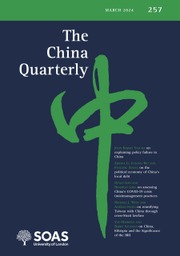No CrossRef data available.
Article contents
The Impact of Non-profit Regulatory Instruments on Civic Engagement Intention in China
Published online by Cambridge University Press: 13 November 2024
Abstract
In China, both governments and civil institutions play important roles in non-profit regulation. However, with various regulatory instruments available, it remains unclear which has the strongest public support and most effectively promotes civic engagement. This study compared the impact of different non-profit regulatory instruments addressing information disclosure on two aspects of civic engagement intention: willingness to donate and willingness to volunteer. A survey experiment was conducted to analyse the perspectives of 939 Chinese participants on four types of regulation: no regulation, civil regulation, accommodative government regulation and deterrent government regulation. Results showed that regulation was preferred to no regulation and deterrent government regulation was preferred to accommodative government regulation, which was preferred to civil regulation. Additionally, public trust in non-profits significantly mediated the relationship between regulation and civic engagement intention. These findings suggest that government regulation, particularly the deterrent approach, garners strong public support and may be prioritized within the Chinese context.
摘要
在中国,政府和民间机构在非营利组织监管中发挥着重要作用。然而,尽管存在多种监管工具,目前尚不清楚哪种工具获得的公众支持最强,能够最有效地促进公民参与。本研究比较了不同非营利组织信息披露监管工具对两方面公民参与意愿的影响:慈善捐赠意愿和志愿服务意愿。通过对 939 名中国参与者进行的调查实验,文章分析了他们对以下四种监管类型持有的观点:无监管、民间监管、弹性政府监管和威慑性政府监管。结果显示,相较于无监管,监管更受欢迎;威慑性政府监管优于弹性政府监管,弹性政府监管优于民间监管。此外,公众对非营利组织的信任在监管与公民参与意愿之间发挥着显著的中介作用。这些发现表明,政府监管,特别是威慑性手段,获得了强烈的公众支持,并应在中国背景下优先考虑。
Keywords
- Type
- Research Article
- Information
- Copyright
- Copyright © The Author(s), 2024. Published by Cambridge University Press on behalf of SOAS University of London



